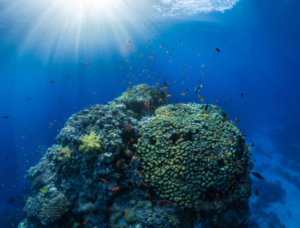Protecting Oceans, One Fin at a Time

In the vast expanse of our oceans, a silent battle rages on—one that threatens the delicate balance of marine ecosystems and endangers some of the ocean’s most majestic inhabitants. Shark finning, the practice of harvesting shark fins for consumption, poses a severe threat to the world’s shark populations and, by extension, the health of our oceans. In this beauty blog, we delve into the depths of this issue, exploring the impact of shark finning on marine ecosystems and the beauty of our oceans, as well as the global efforts to combat this destructive practice.
Sharks, often misunderstood and vilified, play a crucial role in maintaining the health of marine ecosystems. These apex predators contribute to the balance of the food chain, regulating populations of prey species and ensuring the overall well-being of the ocean. Beyond their ecological significance, sharks embody a unique and awe-inspiring beauty. Their sleek, streamlined bodies and graceful movements evoke a sense of power and elegance that captivates divers and nature enthusiasts alike.
The Dark Side of Beauty: Shark Finning
As we delve deeper into the disconcerting practice of shark finning, it’s essential to unravel the intricate details that characterize the dark side of this industry. The allure of shark fins, particularly for their use in traditional Asian delicacies like shark fin soup, has fueled a lucrative market that places sharks at the center of a perilous journey from the depths of the ocean to the dining tables.
- The Brutal Harvest: Shark finning involves the ruthless extraction of fins from live sharks, a process that is both cruel and ecologically devastating. Once a shark is caught, fishermen haul it aboard their vessels, often mutilating the animal while it is still alive. The fins are then sliced off, and the helpless shark, now devoid of its primary means of propulsion, is callously tossed back into the ocean. Unable to swim effectively, the shark faces a slow and agonizing death, sinking to the ocean floor or succumbing to predators.
- Wasteful Practices: Shockingly, the wastefulness of shark finning extends beyond the initial cruelty inflicted upon the sharks. After the fins are removed, the remainder of the shark’s body is discarded at sea. This wasteful practice is not only ethically problematic but also contributes to the depletion of shark populations. The imbalance created by discarding large numbers of sharks disrupts marine ecosystems, affecting not only the sharks themselves but also the myriad species dependent on a healthy ocean environment.
- The Scale of the Issue: The scale of shark finning is staggering, with millions of sharks falling victim to this practice each year. The demand for shark fins, driven by cultural traditions and the belief in their supposed health benefits, has led to the exploitation of numerous shark species, many of which are now classified as endangered or critically endangered. From the iconic great white shark to the elusive hammerhead, a myriad of species face the imminent threat of extinction due to the insatiable demand for their fins.
- Illegal Trade and Organized Crime: The shark fin trade often operates within a shadowy realm of illegality, with many fishermen engaging in unregulated and undocumented practices. The lucrative nature of this industry has attracted organized crime, further complicating efforts to curb shark finning. Illicit trade routes snake their way across the globe, making it challenging for authorities to monitor and intercept shipments of shark fins, perpetuating the cycle of exploitation.
- Erosion of Cultural Myths: Part of the challenge in combating shark finning lies in dispelling long-held cultural myths surrounding the purported benefits of consuming shark fins. While shark fin soup has been considered a delicacy in some Asian cultures for centuries, modern conservation efforts strive to educate and reshape attitudes toward this traditional dish. By challenging the misconception that shark fins hold unique health benefits, conservationists aim to erode the demand that sustains the brutal practice of shark finning.
- Underreporting and Data Gaps: Shark finning is exacerbated by underreporting and data gaps in many regions, making it difficult to assess the true extent of the issue. Inadequate monitoring and reporting mechanisms allow illegal and unregulated fishing practices to persist, hindering conservation efforts and perpetuating the threat to shark populations.
The depletion of shark populations due to finning has cascading effects on marine ecosystems. Without the presence of these apex predators, the populations of their prey species can explode, leading to overgrazing of vital marine vegetation and destabilizing the delicate balance of the ecosystem. This domino effect, known as trophic cascades, can have far-reaching consequences, affecting everything from the health of coral reefs to the abundance of commercially important fish species.
Coral Reefs and Biodiversity
Coral reefs, often referred to as the rainforests of the sea, depend on a delicate harmony among the diverse species that inhabit them. Sharks play a crucial role in maintaining this balance by regulating the populations of herbivorous fish that graze on algae, preventing the overgrowth of algae that could smother coral. As shark populations decline, this balance is disrupted, and coral reefs face increased vulnerability to degradation.
Beyond their impact on coral reefs, sharks contribute to the overall biodiversity of the ocean. Their presence supports the health and resilience of marine ecosystems, fostering a rich tapestry of life beneath the waves. The beauty of the ocean lies not only in its vibrant colors and intricate formations but also in the intricate relationships between its inhabitants—a delicate dance that is threatened by the practice of shark finning.

Global Initiatives for Ocean Conservation
Amid the looming threat of shark finning and its profound impact on marine ecosystems, a global movement has emerged, comprised of dedicated individuals, organizations, and governments working tirelessly to protect our oceans. These initiatives aim not only to combat shark finning but also to address broader issues of marine conservation. Let’s explore the diverse and impactful global efforts underway to safeguard the beauty beneath the waves.
- Legislation and International Agreements: Governments around the world are recognizing the urgency of addressing shark finning through legislation and international cooperation. Numerous countries have implemented bans on shark finning within their waters, with some going further to prohibit the trade and possession of shark fins. Additionally, international agreements such as the Convention on International Trade in Endangered Species of Wild Fauna and Flora (CITES) play a pivotal role in regulating the global trade of certain shark species. These legal frameworks create a foundation for coordinated action on a global scale.
- Marine Protected Areas (MPAs): Establishing Marine Protected Areas (MPAs) is a key strategy to conserve marine biodiversity and protect critical habitats. By designating specific areas where human activities, including shark fishing, are restricted or prohibited, MPAs offer a refuge for sharks and other marine species to thrive. Collaborative efforts between governments, conservation organizations, and local communities have resulted in the creation of MPAs that serve as sanctuaries for sharks and contribute to the overall health of marine ecosystems.
- Technological Innovations for Monitoring: The vastness of the ocean poses challenges for monitoring and enforcement efforts. However, advancements in satellite technology, artificial intelligence, and data analytics are providing new tools to track and combat illegal fishing practices, including shark finning. These technologies enable real-time monitoring of vessel movements, helping authorities detect and respond to suspicious activities, ultimately enhancing the effectiveness of conservation measures.
- Public Awareness and Education Campaigns: The battle against shark finning extends beyond legal and technological measures—it involves changing hearts and minds. Numerous organizations are undertaking public awareness and education campaigns to inform consumers about the environmental and ethical implications of shark fin consumption. By dispelling myths surrounding the cultural significance of shark fin soup and fostering a deeper understanding of the vital role sharks play in marine ecosystems, these campaigns seek to create a shift in consumer behavior.
- Corporate Responsibility and Certification Programs: Businesses within the seafood and hospitality industries are increasingly recognizing their role in driving demand for shark fins. Through corporate responsibility initiatives, some companies are committing to sustainable sourcing practices, pledging not to serve or sell shark fin products. Certification programs, such as the Marine Stewardship Council (MSC) and Aquaculture Stewardship Council (ASC), help consumers make informed choices by identifying products sourced from fisheries and aquaculture operations that meet rigorous sustainability standards.
- NGO-led Conservation Projects: Non-governmental organizations (NGOs) are at the forefront of conservation efforts, implementing projects that directly contribute to protecting sharks and preserving marine ecosystems. These initiatives encompass a wide range of activities, from conducting scientific research on shark populations to engaging in community-based conservation projects that empower local communities to participate in marine protection efforts.
- International Collaboration and Partnerships: Recognizing the transboundary nature of ocean conservation, international collaboration and partnerships are crucial. Countries, NGOs, and research institutions are joining forces to share knowledge, expertise, and resources. Initiatives like the Global Shark and Ray Initiative (GSRI) bring together diverse stakeholders to develop and implement strategies for the sustainable management of shark and ray populations on a global scale.

Beauty Brands Making a Difference
The beauty industry, with its global reach and influence, is also playing a role in the fight against shark finning. Several beauty brands are taking a stand against the use of shark-derived ingredients in their products. By embracing sustainable sourcing practices and raising awareness about the impact of shark finning, these brands are aligning their values with the growing demand for ethical and environmentally conscious beauty products.
Consumers, too, have the power to make a difference by choosing products that support ocean conservation. By opting for beauty brands that are committed to sustainable and cruelty-free practices, individuals can contribute to the global effort to protect sharks and preserve the beauty of our oceans.

As we navigate the complex and interconnected web of life in our oceans, it becomes evident that the beauty of the underwater world is intricately tied to the health and well-being of its inhabitants. The fight against shark finning is not just a conservation effort; it is a commitment to preserving the beauty of our oceans for generations to come.
Through collective action, from global initiatives to individual choices, we can protect oceans, one fin at a time. By appreciating the elegance of sharks and recognizing their vital role in marine ecosystems, we can work towards a future where the beauty beneath the waves remains vibrant and thriving—a testament to the resilience and interconnectedness of our planet’s most precious ecosystems.

